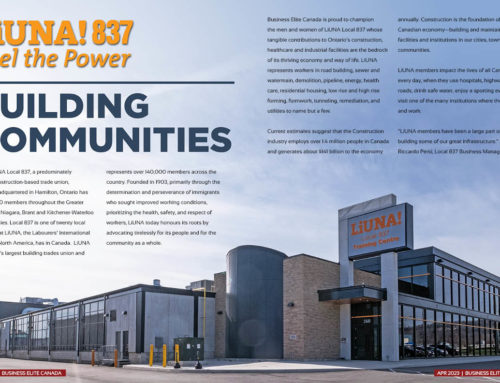The transition back into civilian life can be very challenging for the men and women who give so much in the service of our country.
Every year, approximately 8,000 people retire from the Canadian Armed Forces, who then need to find meaningful employment in this new life chapter. Canadian Veterans leave the Forces with highly sought-after qualities, including discipline and a penchant to work hard. And while many skills acquired in the military transition well into civilian life, there can still be many obstacles to overcome. This can be a daunting experience: adjusting to a less regimented lifestyle, adapting to new cultural norms and competing with other Canadians to find meaningful and well-paying employment. Furthermore, a lot of their training and experience is not recognized or accredited by civilian or government agencies.
Helmets to Hardhats (H2H) Canada, a registered non-profit organization, was created to help eliminate such obstacles. Since its inception in 2012, H2H has referred over 2,600 military community members into well-paying second careers with Canada’s Building Trades Unions. By working with the unionized construction industry, H2H ensures their clients receive only the best industry wages, benefits and pension plans.
“Unfortunately, not everyone who transitions out of the Canadian Armed Forces into a civilian career has access to a support system that can help them overcome the obstacles of finding a well-paying and meaningful second career,” James Hogarth, Executive Director of Helmets to Hardhats Canada.
Helmets to Hardhats aims to harness the valuable skillsets—dedication, leadership and teamwork—that the military community gains through their military experience and transfer those assets into second careers in the skilled trades to the mutual benefit of Canada’s unionized construction industry. Helmets to Hardhat’s mandate is to build lasting connections between the military community members seeking second careers in Canada’s highly skilled construction industry.
A Veterans Affairs Canada report indicated that the 2021 Veteran population was 617,800, with 32 per cent of Veterans being in the core working age group, between 25 and 54. The average age of a Helmets to Hardhats client is 32 years old. With the demand for skilled labour across Canada at an all-time high, many Veterans have a long working career ahead of them to help fill gaps in Canada’s labour force.
“In partnership with construction trade unions, governments and industry, H2H streamlines the pathways to apprenticeship, advanced training and career placement opportunities in the unionized construction industry with registered employers who support the men and women who have served our country.”
The H2H program continues to expand its efforts to raise awareness about careers in the skilled trades to Veterans across Canada. In 2021, H2H hired outreach specialists to better connect with the women and 2SLGBTQ2+ Veteran community and just recently added another outreach worker who will focus on communicating and facilitating skilled trades opportunities with Indigenous Veterans and youth (associated with the Cadet or Junior Canadian Ranger Programs). H2H wants to ensure that every Veteran, no matter who they are or their personal circumstances, is able to access its services and find rewarding careers in the skilled trades without having to deal with barriers to employment.
Aboriginal Veterans Autochtones (AVA)
On top of their ongoing outreach initiatives, H2H and Aboriginal Veterans Autochtones (AVA) joined forces with a MOU ensuring Indigenous Veterans across Canada are aware of careers available in the skilled trades.
“The collaboration with Aboriginal Veterans Autochtones (AVA) was born from the need to reach all Canadian Armed Forces (CAF) Veterans,” says Hogarth. “AVA provides H2H with cultural awareness and advice on outreach strategies. The national AVA network provides an avenue through which H2H can extend the message of second-career opportunities in the unionized construction sector in Canada. With 5.2 per cent of all CAF Veterans self-identifying as Indigenous, a better understanding of individual needs and obstacles can reduce barriers to meaningful employment.”
“At Helmets to Hardhats, we believe that because of the dedicated service of our Veterans, it is now our responsibility to provide our services to Veterans as they find meaningful second careers in the unionized construction industry,” say Hogarth. “This is the mission that drives Helmets to Hardhats, as we think about Veterans every day, all year long.”
How you can support H2H
Hogarth says this is an exciting time to work with Helmets to Hardhats. “The program continues to build upon its successes and looks forward to a bright future serving Veterans and the Unionized construction industry across Canada,” he says. “I can only see Helmets to Hardhats growing over the next ten years. As more young men and women leave the military, many will already be familiar with H2H and the opportunities we have available for them. As Canada aims to fill skill shortages, the military community will be a vital demographic to utilize within Canada’s Building Trade Unions.”
H2H encourages prospective clients to register with them in order to access their varied services. H2H is able to support registered participants with resume building, accessing information on how to transfer military qualifications to the civilian work site and, most importantly, for apprenticeship referrals. As a registered employer, you can acquire a trained, skilled and reliable workforce through their online database. Working with Helmets to Hardhats also gives you free access to hundreds of resumes, ability to post careers you need filled and search functions to find employees near you. Helmets to Hardhats is the gateway into the unionized construction industry for the military community but continues to ensure Canada’s Building Trade Unions are getting the value added by a Veteran to fill labour shortages.
To learn more about H2H, please visit www.helmetstohardhats.ca






